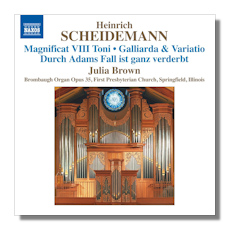
The Internet's Premier Classical Music Source
Related Links
- Scheidemann Reviews
- Latest Reviews
- More Reviews
-
By Composer
-
Collections
DVD & Blu-ray
Books
Concert Reviews
Articles/Interviews
Software
Audio
Search Amazon
Recommended Links
Site News
 CD Review
CD Review
Heinrich Scheidemann

Organ Works Volume 6
- Mio cor se vera sei Salamanca
- Magnificat im 8 Ton
- Herr Christ, der einig Gotts Sohn
- Galliarda variata
- Fantasy in C major, WV 82
- Durch Adams Fall ist ganz verderbt
- Courante and Variations
- Benedicam Dominum in omni temporae
- Ballet and Variation in D minor
- Allemand in D minor
- Victimae paschali laudes, WV 68
- Praeambulum in E minor, WV 38
- Mascarata and Variations in G Major, WV 110
- Wär Gott nicht mit uns diese Zeit, WV 70
- Wo Gott der Herr nicht bei uns hällt, WV 71
Julia Brown, organ
Naxos 8.573118
The music of Heinrich Scheidemann (1595-1663) really is music which deserves to be better known. And this series of wonderful recordings of his keyboard compositions by Julia Brown on Naxos (here she plays a modern Brombaugh organ in Springfield Illinois) is helping. It's the sixth in a projected series of seven CDs of music by the early Baroque composer. Volumes 3 (Naxos 8.554548), 4 (Naxos 8.573118), and 5 (Naxos 8.557054), for instance, were well received on Classical Net.
Scheidemann's music occupies a place where the genteel meets the restrainedly passionate. Brown has the measure of the balance that's needed to convey both animation and control. Her tempi are consistent; they use that regularity (which is, though, never devoid of variety and interest) appropriately to emphasize the gravitas that is integral to the composer's music. It has qualities of the regal and the stately. But is never pompous nor grandiose. Indeed, much of the music here is slow and accrues self-assurance in those unhurried qualities.
At the same time, Brown puts the humanity and warmth of Scheidemann's music to the fore. The intimacy of ornamented details, repeated phrases – usually with subtle variation – and melodic and tonal/harmonic reflections on previous and future material and passages make the music approachable. At he same time, it's neither trivial nor minute in scope.
Several of the works on this CD are transcriptions of vocal compositions – including those by other composers. Although, it's true, this adds an extra element of implied logic (texts) to the musical development, Brown's expositions address Scheidemann's lyricism and sharply-tuned sensibilities regardless. The same goes for the dance-inspired numbers here (for which no instrument was necessarily specified). Though, again, the innate life in the music emerges with Brown's clear understanding of Scheidemann's motives and skills no matter which his medium. That improvisation is central to the composer's style and priorities; it's handled as carefully and generously by Brown here as it was common in Scheidemann's time.
The major work is the Magnificat in 8 Tones [tr.s 2-5]. It's an open, but not extrovert, work in four Verses. Brown plays it with complete understanding and appreciation of the architecture and need for it to unfold in its own time, making its musical impact gently, without rush; yet without impediment. The same goes for the single longest piece on the CD, Herr Christ, der einig Gotts Sohn for organ [tr.7], which is as devotionally rich as it is melodically varied. This is a characteristic of Scheidemann: the music, for all its originality and inventiveness, is in the service of the composer's faith and the Protestant tradition in which it is embedded. At the same time, Brown plays the music as music: for all the passion of Victimae paschali laudes [tr.9] and the pair of plaintive yet rejoicing dual Verses, Wär Gott nicht mit uns diese Zeit and Wo Gott der Herr nicht bei uns hällt [tr.s 13,14 and 16,17], the music is substantial enough and sufficiently well-crafted to stand independently. As throughout this collection, Brown is informed by the broad confessional context; but treats the music as a creation in its own right.
The acoustic is warm and close with just the right amount of resonance from the First Presbyterian Church organ such that spurious atmosphere isn't allowed to dominate the music. Though there is enough of a sense of the organ's personality – particularly in the slower and quieter works like the fourth Verse of the Magnificat, WV 20 [tr.5], a study in restraint – for an added frisson of pleasure to be present. If anything – when compared with the great European organs – this instrument has (or has been recorded with) a slightly diminished dynamic range. The booklet is to the usual Naxos standard; a concentration of details of the music, the instrument and (briefly) the performer to guide you through what is likely to be relatively unfamiliar territory… there are other recordings of some of the works here, but mostly in multi-composer anthologies. If you've been collecting this excellent series, you'll not want to hesitate. If the richness of Baroque organ music of the North German school is new or appealing, this is a good place to start. Recommended.
Copyright © 2013, Mark Sealey





















